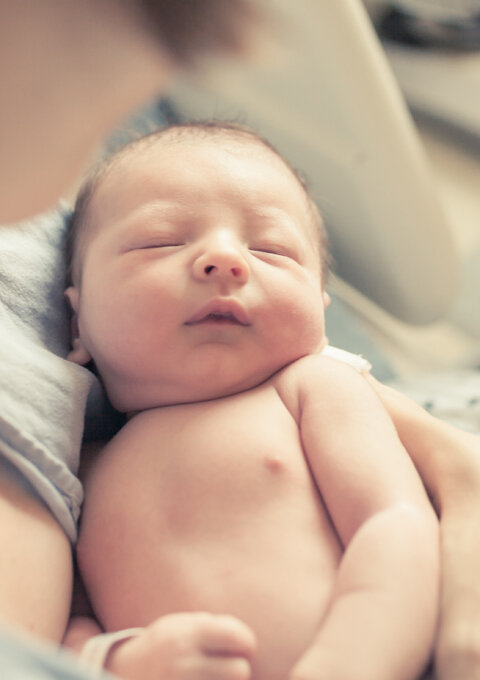Week by week we follow your baby’s growth and changes in your body. We advise you on health and diet during your pregnancy.
A caesarean section (also known as C-section or caesarean delivery) is a surgery that leaves a wound. Find out how to treat a c-section wound to make the healing process fast and smooth.
Expert consultant: Katarzyna Orawiec-Rymszewicz – midwife, lactation educator
A caesarean section is a major operation. During a C-section, the doctor makes an abdominal incision and an incision in the uterus. They gently pull out a baby. Then, they take out the placenta and suture the uterus, fascia and skin tissues.
Just after the surgery, you will be taken to a recovery room where you spend a few hours. Although a caesarean section is usually faster than a natural birth and, thanks to anaesthesia, does not hurt, the recovery itself is longer and more difficult. And your C-section scar will be fully healed only after 5 to 7 months.
Immediately after the procedure, you will not be able to sit or move rapidly. After the anaesthesia wears off, you may experience pain and discomfort, so you will be given some painkillers. The C-section wound will be covered with a sterile dressing. Remember not to soak it. If you soak it by accident, inform the midwife and ask her to change the dressing.
Air promotes C-section wound healing, so whenever possible, expose your wound to air by taking care of the right underwear. Remember that your postpartum underwear shouldn’t be too tight and shouldn’t irritate your skin. Wear loose clothing and air the C-section wound whenever possible. Wash your hands frequently, especially after using the toilet. Remember, that bacteria can multiply quickly in postpartum bleeding (lochia). If those bacteria are transferred unintentionally, your C-section wound can get infected.
Keep your C-section wound clean by washing it 2-3 times a day. Use warm water and soap, and afterwards pat the area dry with a paper towel. Then disinfect your wound with a special antiseptic. The stitches are usually removed about a week after surgery.
Usually, a C-section scar is about 10-15 cm long. It can be flat or slightly convex, with a slight red tint. It will become lighter and lighter over time. Usually, it is 3.5 mm thick and is located just above the pubic symphysis (above your pubic hairline). So you will be able to easily cover it with your underwear.
In the first months after the C-section, avoid any high-impact exercises. Before you decide to jump into your exercise regimen, consult your gynaecologist.
However, your C-section scar needs some mobilization. Start with a massage. It will improve skin elasticity and help to reduce adhesions. A properly done C-section scar massage helps the scar tissue from growing in unwanted places, smooths out thick scars and helps skin to become more relaxed. Moreover, sometimes during the healing process imperfections appear deeper under the skin, causing inflammation. A C-section scar massage will help prevent it.
To see improvement, you should massage your scar tissue and the area around it systematically. You can do it with your bare hands or with the help of special massagers. Just gently and firmly press finger pads (or a special massager) into the scar and area around it using small circular motions. The pressure will inhibit growth. You can also buy scar gels and scar creams at the pharmacy. Their main aim is to soften your scar tissue.
For the duration of scar healing, give up long baths. Replace them with a shower. Avoid heavy lifting as it can strain your abdominal muscles. Don't worry if the scar itches. This is a normal symptom that indicates regeneration and skin recovery.
See your doctor if your C-section scar hurts. Discomfort during a few weeks after surgery is normal, but it is wise to check if everything is OK. Swelling and redness around your scar may indicate an infection. Pain in the lower abdomen, pain during urination, bleeding or trouble getting pregnant again can be signs of adhesions.
After a caesarean section, the doctor should perform an ultrasound to see if everything is healing properly. You can also see a physiotherapist or urogynaecologist. They will be able to examine your pelvic floor muscles and teach you how to mobilize your C-section scar.
The labour is over! Congratulations! It was really hard and now you need some time to regain your strength and good condition. This time is called puerperium. Read more to learn what is going on with your body, what you should ...
Winter has come with its beautiful snowy landscapes, but, unfortunately, also with awful weather and wet feet. Disease does not discriminate and everybody can go down with cold. How to deal with it when you are pregnant?
There are some things you do not talk loud and often about, however, they are worth knowing when you are pregnant. Here you can read why a pregnancy favors intimate infections, whether they can pose a risk to your baby, and ...
Are you getting ready for childbirth? Are you planning a natural birth, but you know from other women's experience that is not always possible? Or maybe you already have had a date for a C-section scheduled due to obstetric ...
Week by week we follow your baby’s growth and changes in your body. We advise you on health and diet during your pregnancy.
